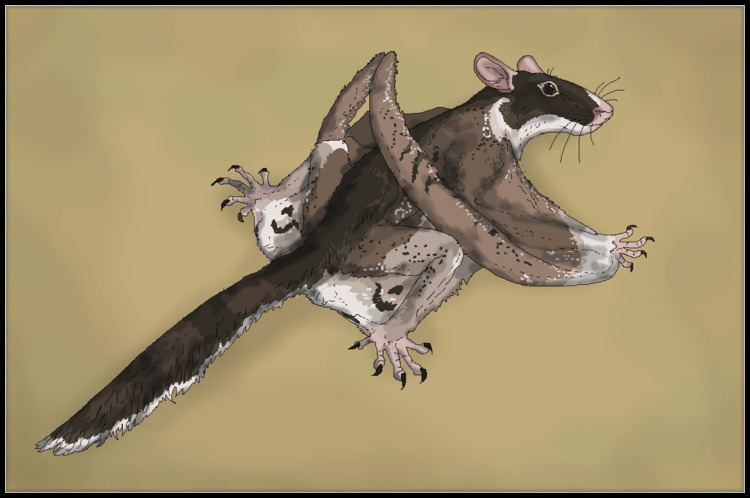Phylum Chordata | Subphylum Vertebrata Family †Volaticotheria Rank Genus | |
 | ||
Similar Argentoconodon, Eutriconodonta, Jugulator, Triconodontidae, Volaticotherium | ||
Ichthyoconodon is an extinct genus of theriimorph mammal from the Lower Cretaceous of Morocco. Usually considered an eutriconodont, it is notable for its oceanic location and atypical shape, indicative of potentially unusual ecological niches; some researchers think that it may be the first marine mammal, or part of a bizarre clade of gliding mammals.
Contents
Description
Ichthyoconodon is known primarily from isolated teeth from Anoual Syncline sediments of Morocco, in particular strata thought to date to the Berriasian. These teeth, mostly molars, possess many synapomorphies associated with volaticotherian eutriconodonts, rather atypical and unique to the clade. The molars are about 4 millimeters long, indicating a size comparable to the related Jugulator.
Etymology
Ichthyoconodon essentially means "fish cone tooth", from the greek ιχθυς, "fish", κῶνος, "cone", and ὀδών, "tooth". The type species, I. jaworowskorum, was named "in honour of Zofia Kielan-Jaworowska and Zbigniew Jaworowski for their generous hospitality on many occasions".
Relationships
Ichthyoconodon has been found to be a eutriconodont, though the degree of speciation has been noted as being difficult to assess its status as such. Rose et al. found some skepticism about a eutriconodont identity, and some studies have suggested an identity not even as a mammal, but as a pterosaur, but most recent phylogenetic studies favour a eutriconodont identity.
The most recent phylogenetic studies favour a close relationship with Volaticotherium, Jugulator, Triconolestes and Argentoconodon within Volaticotheria. A relationship between it and Volaticotherium has been suggested as far back as the latter's description, albeit not as eutriconodonts.
Ecology
Ichthyoconodon's teeth are located in marine deposits, alongside taxa like hybodontid sharks, ornithocheirid pterosaurs, ray-finned fish and sea turtles, as well as several terrestrial taxa like theropods. Unlike other mammal teeth, including other contemporary teeth such as those of Hahnodon, which show some degree of degradation, Ichthyoconodon teeth are not significantly modified, ruling out the possibility that the animal was carried over from river deposits. This means that the mammal either died in situ or was only carried over for a short distance.
Because the teeth of Ichthyoconodon are rather sharp and convergent in some details to the teeth of piscivorous mammals like otters and seals, some researchers have suggested that it was a marine mammal. If this is the case, it is by far one of the two earliest known mammal species to have adapted to live in the sea, alongside the contemporary Dyskritodon amazighi. The Jurassic and Cretaceous docodonts like Castorocauda and Haldanodon, Early Cretaceous monotremes and the Late Cretaceous Didelphodon have also specialised for an aquatic lifestyle, but Ichthyoconodon and Dyskritodon amazighi would have been the only known Mesozoic mammals to have foraged in the sea.
However, other researchers such as Zofia Kielan-Jaworowska argued a lack of functional comparison between eutriconodont teeth and those of marine mammals. Unlike the teeth of seals and cetaceans, eutriconodont molars occlude, creating a shearing motion like carnassials and unlike the grasping function of marine mammal molars. In her discussion of Astroconodon she brought up Ichthyoconodon and Dyskritodon as eutriconodonts found in aquatic deposits, but did not address their high status of preservation in a marine location, merely addressing Astroconodon's freshwater occurrences.
Alternatively, Ichthyoconodon may have been a glider, based on its relationship with the gliding Volaticotherium and the possibly also volant Argentoconodon. The presence of Argentoconodon in South America, Volaticotherium in Asia and Ichthyoconodon in North Africa in such a relatively close span of time suggests there may have been a widespread clade of Jurassic-Early Cretaceous gliding triconodonts.
Aquatic or volant, Ichthyoconodon would have been most likely carnivorous. Eutriconodonts possess several adaptations towards carnivory, including shearing molars like those of modern carnivorous mammals.
